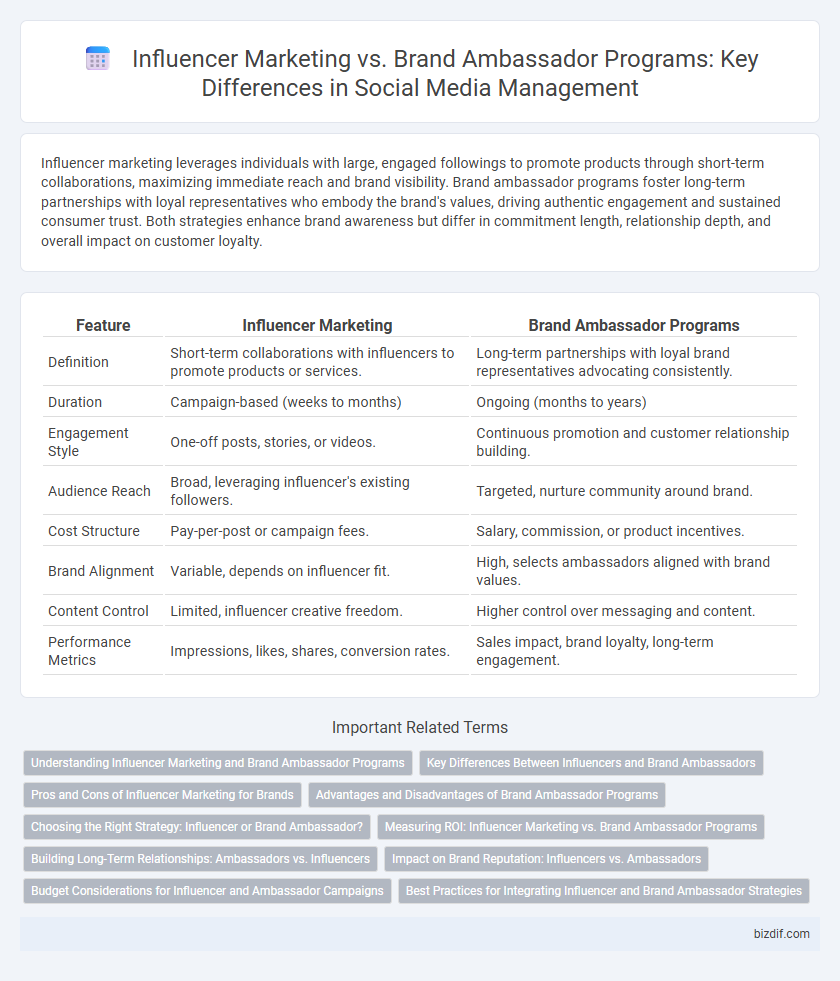Influencer marketing leverages individuals with large, engaged followings to promote products through short-term collaborations, maximizing immediate reach and brand visibility. Brand ambassador programs foster long-term partnerships with loyal representatives who embody the brand's values, driving authentic engagement and sustained consumer trust. Both strategies enhance brand awareness but differ in commitment length, relationship depth, and overall impact on customer loyalty.
Table of Comparison
| Feature | Influencer Marketing | Brand Ambassador Programs |
|---|---|---|
| Definition | Short-term collaborations with influencers to promote products or services. | Long-term partnerships with loyal brand representatives advocating consistently. |
| Duration | Campaign-based (weeks to months) | Ongoing (months to years) |
| Engagement Style | One-off posts, stories, or videos. | Continuous promotion and customer relationship building. |
| Audience Reach | Broad, leveraging influencer's existing followers. | Targeted, nurture community around brand. |
| Cost Structure | Pay-per-post or campaign fees. | Salary, commission, or product incentives. |
| Brand Alignment | Variable, depends on influencer fit. | High, selects ambassadors aligned with brand values. |
| Content Control | Limited, influencer creative freedom. | Higher control over messaging and content. |
| Performance Metrics | Impressions, likes, shares, conversion rates. | Sales impact, brand loyalty, long-term engagement. |
Understanding Influencer Marketing and Brand Ambassador Programs
Influencer marketing leverages individuals with large, engaged followings to promote products or services through sponsored content, often focusing on short-term campaigns and measurable engagement metrics. Brand ambassador programs involve long-term collaborations where ambassadors authentically represent and consistently advocate for the brand, fostering deeper trust and loyalty among target audiences. Understanding these distinctions helps businesses tailor strategies to maximize reach and build sustainable consumer relationships.
Key Differences Between Influencers and Brand Ambassadors
Influencer marketing targets individuals with broad reach and temporary partnerships, often leveraging trending content to boost short-term engagement and sales. Brand ambassador programs involve long-term collaboration with individuals who deeply embody and consistently promote the brand ethos, enhancing authenticity and trust. Influencers typically focus on campaign-driven content, while brand ambassadors build ongoing brand loyalty through sustained, genuine interactions.
Pros and Cons of Influencer Marketing for Brands
Influencer marketing offers brands rapid audience reach and authentic content creation, driving higher engagement and immediate sales impact. However, it poses risks such as inconsistent messaging, reduced long-term loyalty, and potential influencer controversies that can harm brand reputation. Managing influencer partnerships requires ongoing vetting and performance tracking to ensure alignment with brand values and marketing goals.
Advantages and Disadvantages of Brand Ambassador Programs
Brand ambassador programs offer personalized brand representation, fostering authentic long-term relationships and increased customer trust through consistent messaging. However, they require substantial investment in training and ongoing support, and their effectiveness depends heavily on the ambassador's alignment with brand values and audience engagement. Limited scalability and potential risks of ambassador misalignment can impact brand reputation and campaign consistency.
Choosing the Right Strategy: Influencer or Brand Ambassador?
Choosing the right strategy between influencer marketing and brand ambassador programs hinges on campaign goals and audience engagement. Influencer marketing provides short-term exposure through influencers' broad reach and trending content, ideal for product launches or event promotions. Brand ambassador programs build long-term trust and loyalty by fostering consistent, authentic representation, enhancing sustained brand affinity and deeper customer relationships.
Measuring ROI: Influencer Marketing vs. Brand Ambassador Programs
Measuring ROI in influencer marketing relies heavily on tracking immediate engagement metrics such as click-through rates, conversions, and social media impressions, making it ideal for short-term campaigns. Brand ambassador programs, however, emphasize long-term relationship building and often require assessing changes in brand loyalty, customer lifetime value, and sustained sales growth. Both strategies benefit from advanced analytics tools, but brand ambassador ROI measurement includes qualitative factors like brand sentiment and community trust, beyond quantitative influencer marketing data.
Building Long-Term Relationships: Ambassadors vs. Influencers
Brand ambassador programs prioritize building long-term relationships by consistently representing the brand's values and messaging over time, fostering deeper trust and loyalty with the audience. Influencer marketing typically involves short-term collaborations focused on specific campaigns, offering immediate reach but less sustained engagement. Investing in ambassadors cultivates authentic advocacy and ongoing brand visibility, while influencers provide dynamic, campaign-based promotion.
Impact on Brand Reputation: Influencers vs. Ambassadors
Influencer marketing often delivers rapid brand exposure through diverse and extensive audiences, but its impact on brand reputation can be inconsistent due to varying content authenticity. Brand ambassador programs foster deeper, long-term relationships that enhance trust and credibility, leading to sustained positive perception and stronger brand loyalty. Consistent messaging and authentic endorsements from ambassadors typically result in a more stable and favorable brand reputation compared to influencer campaigns.
Budget Considerations for Influencer and Ambassador Campaigns
Influencer marketing campaigns typically require flexible budgets that can scale based on influencer reach and engagement rates, often involving one-time payments or product exchanges. Brand ambassador programs demand a more consistent investment due to long-term commitments, offering fixed salaries or performance-based incentives to maintain brand loyalty and authenticity. Budget allocations should account for campaign goals, anticipated ROI, and the differing cost structures between short-term influencer collaborations and sustained ambassador partnerships.
Best Practices for Integrating Influencer and Brand Ambassador Strategies
Effective integration of influencer marketing and brand ambassador programs requires aligning influencers' audience engagement metrics with long-term brand loyalty goals. Leveraging data analytics to identify influencers whose values match the brand ensures authentic collaborations that resonate with target demographics. Consistent communication and performance tracking optimize campaign ROI while maintaining a cohesive brand message across both influencer-driven and ambassador-led content.
influencer marketing vs brand ambassador programs Infographic

 bizdif.com
bizdif.com